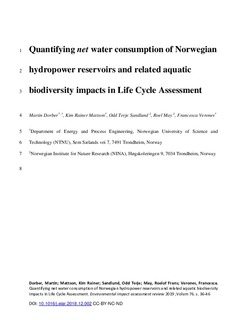| dc.contributor.author | Dorber, Martin | |
| dc.contributor.author | Mattson, Kim Rainer | |
| dc.contributor.author | Sandlund, Odd Terje | |
| dc.contributor.author | May, Roelof Frans | |
| dc.contributor.author | Verones, Francesca | |
| dc.date.accessioned | 2019-02-28T09:32:00Z | |
| dc.date.available | 2019-02-28T09:32:00Z | |
| dc.date.created | 2019-02-01T09:56:46Z | |
| dc.date.issued | 2019 | |
| dc.identifier.citation | Environmental impact assessment review. 2019, 76 36-46. | nb_NO |
| dc.identifier.issn | 0195-9255 | |
| dc.identifier.uri | http://hdl.handle.net/11250/2587962 | |
| dc.description.abstract | Compared to conventional energy technologies, hydropower has the lowest carbon emissions per kWh. Therefore, hydropower electricity production can contribute to combat climate change challenges. However, hydropower electricity production may at the same time contribute to environmental impacts and has been characterized asa largewaterconsumerwithimpactsonaquatic biodiversity.LifeCycleAssessmentisnotyet abletoassessthebiodiversityimpactofwaterconsumptionfromhydropowerelectricityproductiononaglobal scale. The first step to assess these biodiversity impacts in Life Cycle Assessment is to quantify the water con- sumptionperkWhenergyproduced.Wecalculatedcatchment-specificnetwaterconsumptionvaluesforNorway ranging between0 and 0.012m 3 /kWh. Further, we developedthe first characterization factors for quantifying the aquatic biodiversity impacts of water consumption in a post-glaciated region. We apply our approach to quantifythebiodiversityimpactperkWhNorwegianhydropowerelectricity.Ourresultsvaryoversixordersof magnitude and highlight the importance of a spatial explicit approach. This study contributes to assessing the biodiversity impacts of water consumption globally in Life Cycle Assessment. | nb_NO |
| dc.language.iso | eng | nb_NO |
| dc.publisher | Elsevier | nb_NO |
| dc.rights | Attribution-NonCommercial-NoDerivatives 4.0 Internasjonal | * |
| dc.rights.uri | http://creativecommons.org/licenses/by-nc-nd/4.0/deed.no | * |
| dc.title | Quantifying net water consumption of Norwegian hydropower reservoirs and related aquatic biodiversity impacts in Life Cycle Assessment | nb_NO |
| dc.type | Journal article | nb_NO |
| dc.type | Peer reviewed | nb_NO |
| dc.description.version | acceptedVersion | nb_NO |
| dc.source.pagenumber | 36-46 | nb_NO |
| dc.source.volume | 76 | nb_NO |
| dc.source.journal | Environmental impact assessment review | nb_NO |
| dc.identifier.doi | 10.1016/j.eiar.2018.12.002 | |
| dc.identifier.cristin | 1671881 | |
| dc.relation.project | Norges forskningsråd: 244109 | nb_NO |
| dc.description.localcode | © 2019. This is the authors’ accepted and refereed manuscript to the article. Locked until 31.01.2021 due to copyright restrictions. This manuscript version is made available under the CC-BY-NC-ND 4.0 license http://creativecommons.org/licenses/by-nc-nd/4.0/ | nb_NO |
| cristin.unitcode | 194,64,25,0 | |
| cristin.unitname | Institutt for energi- og prosessteknikk | |
| cristin.ispublished | true | |
| cristin.fulltext | postprint | |
| cristin.qualitycode | 1 | |

